Whats on the Back of Glass Gem Stone
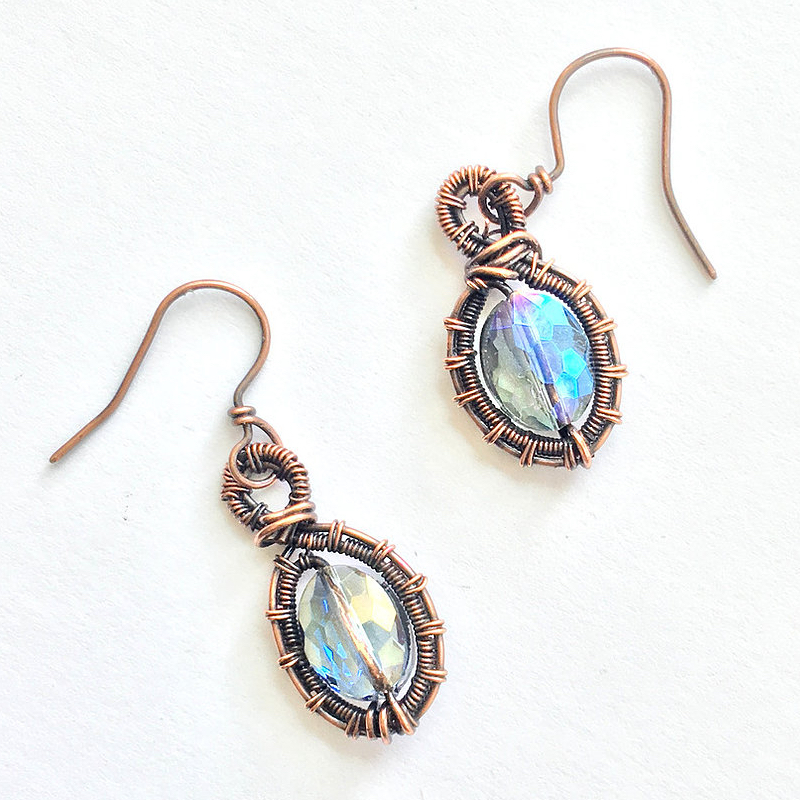
Sparkles, "peacock-colored" glass beads, in woven copper earring frames. Photo © Adornments by Mae. Used with permission.
Glass Gemstones: Facts and Information
Glass is essentially silicon dioxide (SiO2), and quartz sand is its primary source.
This article deals exclusively with the commercially or artisanally created varieties of glass used to simulate gemstones. Natural glasses exist, such as obsidian and tektites. These materials are described in separate articles.
Why is Lead Added to Glass Gemstones?
When added to glass, metals and minerals can create many colors. These additives also have other effects. For example, lead is frequently added to raise refractive index (RI) and dispersion. It also makes the material more durable, a feature characteristic of lead crystal glassware. (Of course, crystal is an inappropriate adjective for amorphous glass). Lead also increases the specific gravity (SG) of some glass varieties. Gemologists may also encounter lead glass not only in simulated gemstones but also in the hemicylinders of refractometers.
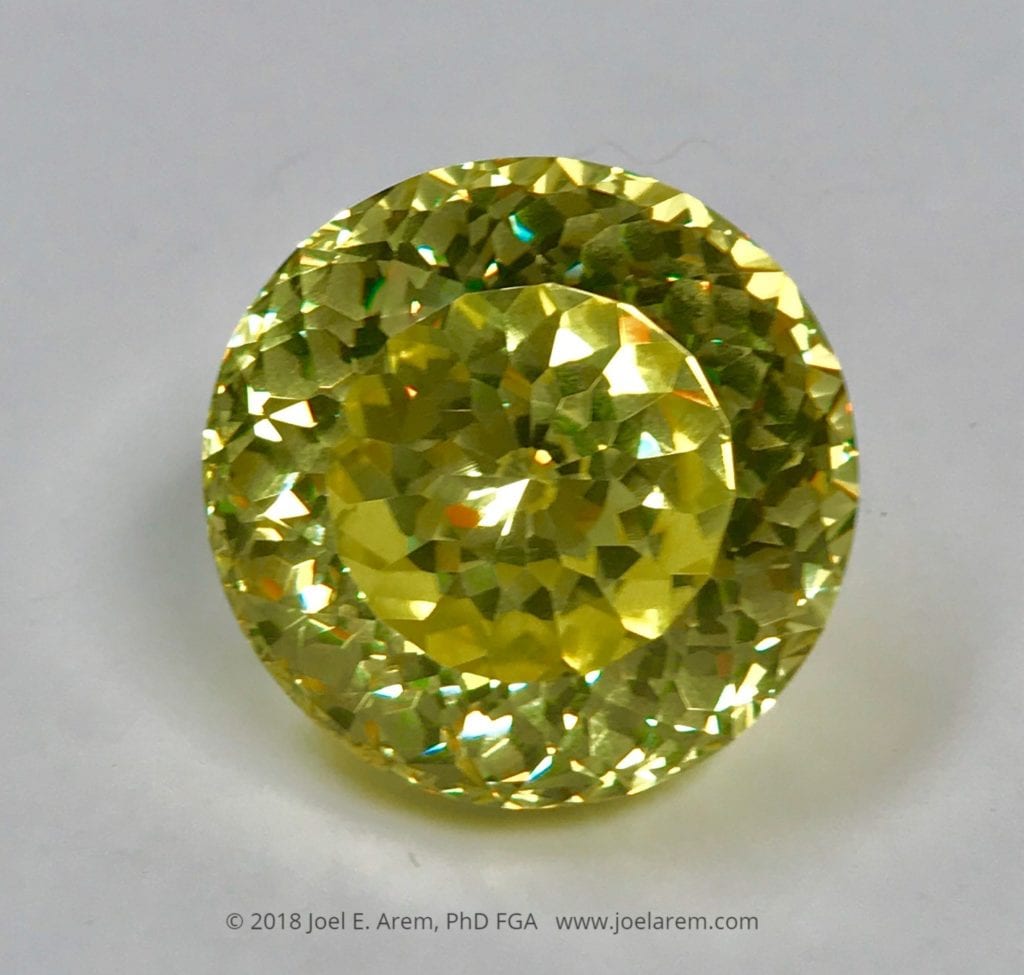
Lead glass, 227 cts. © Joel E. Arem, PhD, FGA. Used with permission.
Identifying Characteristics of Glass Gemstones
Glass can be made and shaped to appear like almost any type of gem. However, its physical and optical properties usually differ significantly from those of the natural gemstones it may resemble.
With just a loupe, gemologists may find many telltale signs of manufactured origins. Glass usually contains inclusions not found in natural gems, such as swirl marks and round bubbles. Glass pieces molded to appear faceted may also have mold marks, rounded facet edges, and concave facets. These form as the pieces shrink when cooling. (Concave facets are otherwise very rarely encountered in faceted gems). However, note that some glass varieties can actually be faceted, so these wouldn't necessarily show round edges or concave facets.
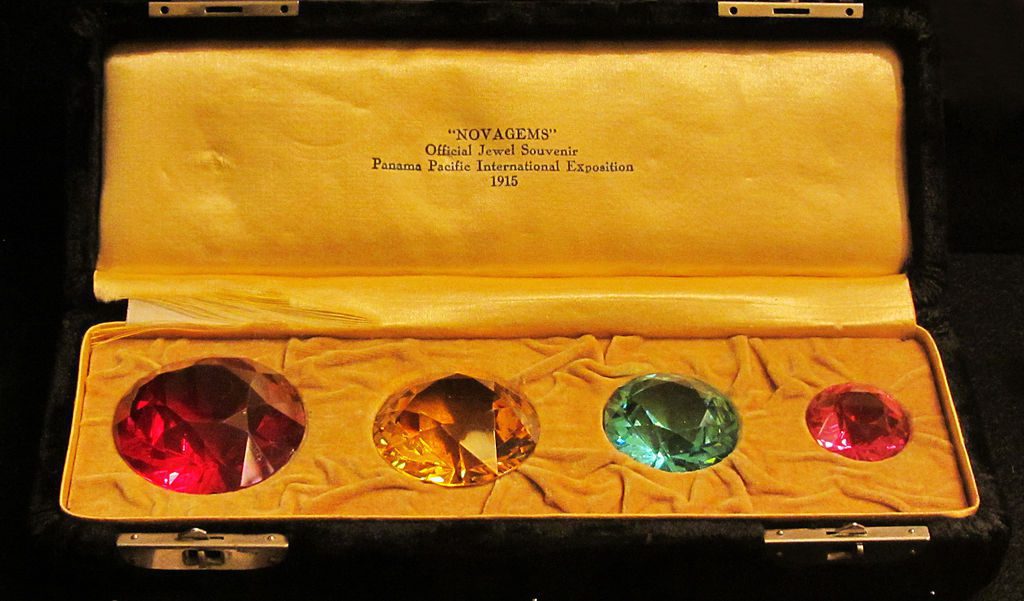
"Novagems" were faceted glass gemstones that hung from the Tower of Jewels, the 435' tall centerpiece building of the 1915 Panama Pacific International Exposition in San Francisco. This official jewel souvenir from the exposition is on display at the California State Capitol Museum. Photo by Lisafern. Public Domain.
Manufactured glass may show an uneven surface sometimes called "orange peel." However, some natural gems can also show such an effect.
Since amorphous glasses conduct heat much faster than crystalline materials, they will feel warm to the touch, much warmer than most of the gems they may resemble.
Although glasses, both synthetic and natural, are singly refractive, they frequently show anomalous double refraction (ADR).
Trade Names and Varieties of Glass Gemstones
Many glass pieces are indeed shaped like traditional finished gems and given colors and other optical effects that imitate natural stones. Jewelry makers may use such pieces as accents or even center stones in their projects. However, as long as the pieces are disclosed as glass to consumers, this isn't a deceptive practice.
Sometimes, glasses may be shaped and designed to look wholly unlike traditional cut gems, and these may be used for ornamentation or worn as jewelry, too.
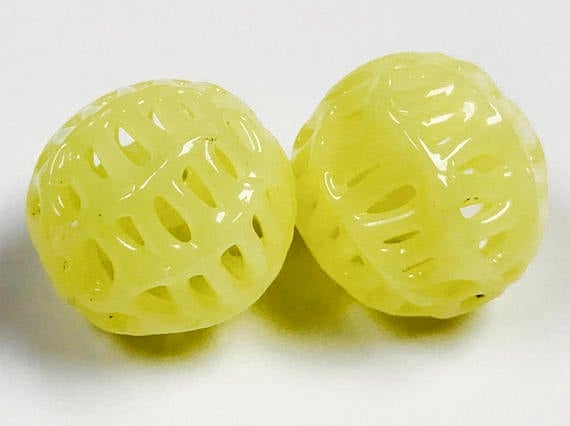
Vintage Japanese lemon yellow spiderweb lace glass beads, 1920s Cherry Brand. Photo © Joel E. Arem, PhD, FGA. Used with permission.
You may encounter many trade names and varieties of glass and glass treatments. The following are some of the most well-known.
Alexandrium™
A trade name for a blue-to-lavender color change glass. (Not to be confused with alexandrite). Li Al silicate (+ Nd); hardness = 6.5; N = 1.58; heat sensitive.
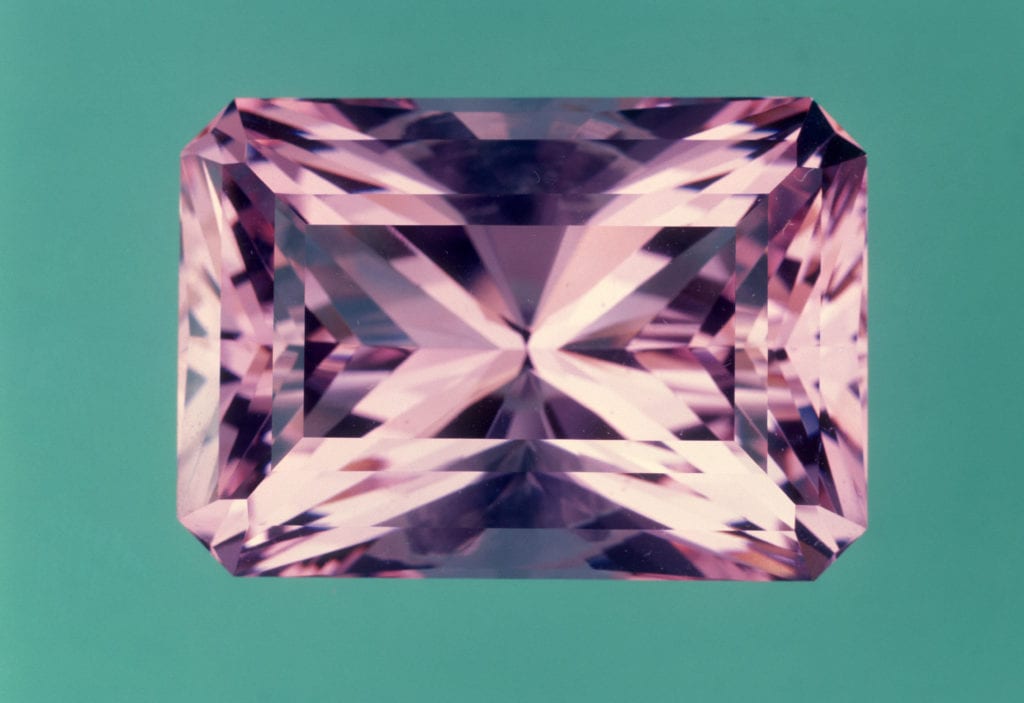
Alexandrium™, 50.40 carats. Photo © Joel E. Arem, PhD, FGA. Used with permission.
Aurora Borealis
Glass with an iridescent coating, sometimes referred to as AB glass. The Swarovski Corporation created this process in 1956. (Not to be confused with the natural obsidian variety of the same name).
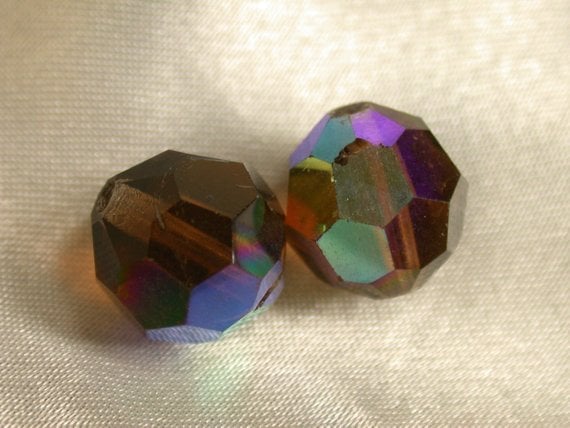
Vintage Swarovski aurora borealis round, faceted glass beads. Photo © Joel E. Arem, PhD, FGA. Used with permission.
Cat's Eye Glass
Chatoyant glass, also known as fire eye. Please note that, aside from natural cat's eye chrysoberyl, some cat's eye stones may also be synthetic chrysoberyl.
Chatons
Also known as chaton foils, colorless glass with foil backs.
Cristinite™
A trade name for a facetable manufactured glass made in Australia.
Faience
A glass-like ceramic used as a glaze on pottery as well as for making beads and other objects. The Ancient Egyptians famously used this material as a turquoise simulant.
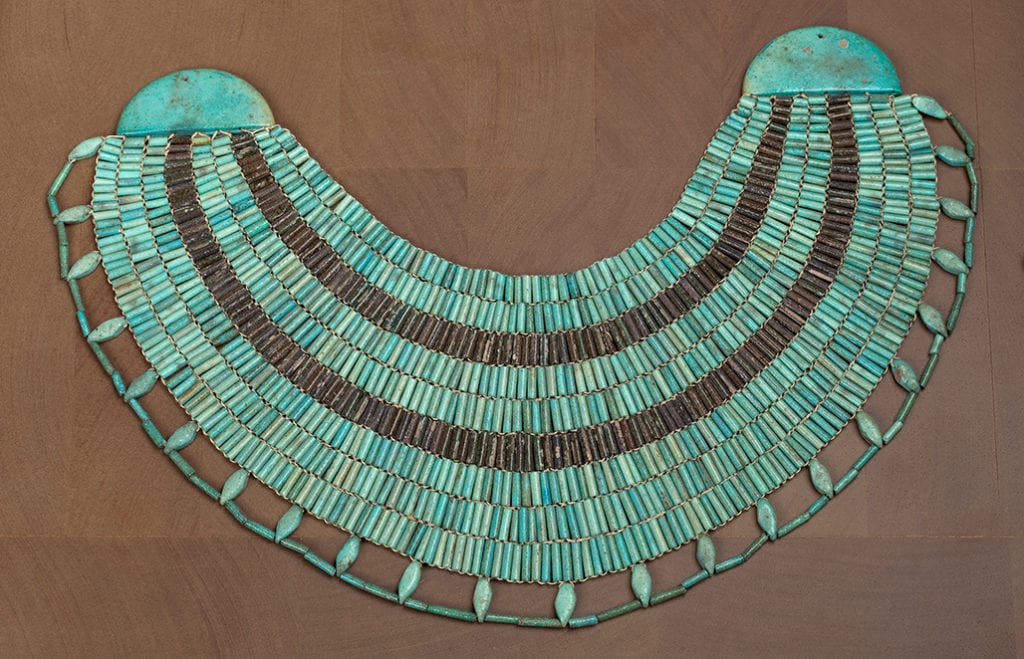
Archeologists discovered this model broad collar in the wrappings of the mummified steward Hapiankhtifi. Museum workers restrung it. Blue-green and black faience, Middle Kingdom Egypt, 1981-1802 BCE, 35 x 13.3 cm. Gift of J. Pierpont Morgan, 1912. Metropolitan Museum of Art, New York. Public Domain.
French Jet
A black, opaque glass used to imitate jet, especially during its fashion heyday in the Mid-Victorian Era. Although glass usually feels warmer to the touch than the gems it may simulate, natural jet (another amorphous material) actually feels warmer than glass. Despite the name, most French jet came from Bohemia (in what is now the Czech Republic).
Goldstone
Also called "aventurine glass," goldstone contains copper or gold-colored inclusions, which cause the sparkling effect known as aventurescence. Some goldstones look like nothing in the natural world.
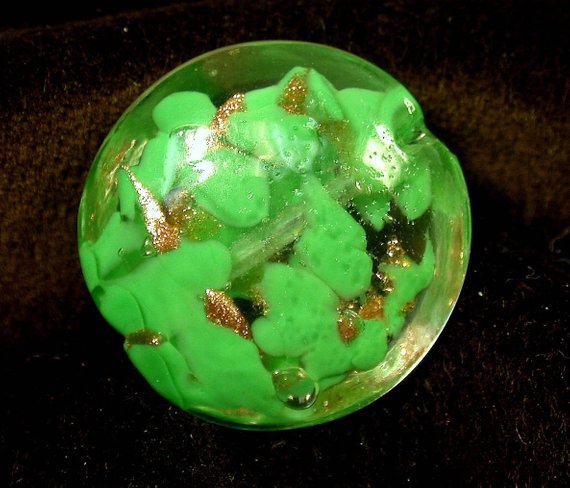
Vintage Venetian green aventurine givre glass bead. You can see the copper foil inside the glass. Photo © Joel E. Arem, PhD, FGA. Used with permission.
Most likely invented in Italy in the 17th century and originally named avventurina, after the Italian a ventura for "by chance," this material actually introduced the term "aventurescence" into mineralogy. Please note that nowadays the name "aventurine" is also applied to natural varieties of quartz and feldspar that display aventurescence. Goldstone may simulate these natural gem varieties.
Laserblue
A rare variety of facetable manufactured glass. Consult the laserblue gem listing for more information.
Opalite
A trade name for a type of glass often used to simulate moonstone or opal. Please note that there is a variety of natural opal also called "opalite." However, this term is primarily used to refer to the glass material.
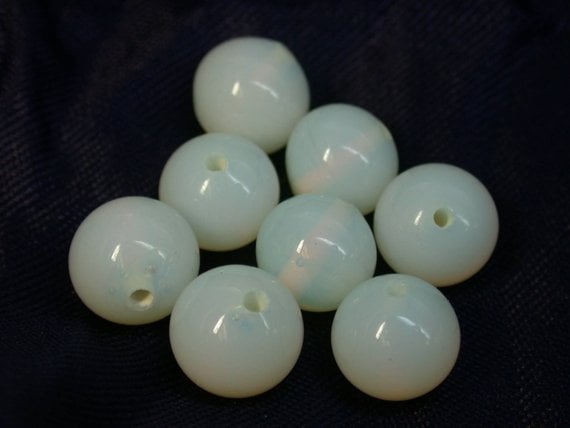
Vintage opalite glass beads. Photo © Joel E. Arem, PhD, FGA. Used with permission.
Paste
Common glass, like that used for bottles, with low RI and dispersion, used to imitate gemstones.
Rhinestone
Historically, clear rock quartz crystals backed with foil, used to imitate diamonds. Nowadays, the name may also apply to leaded glass pieces backed with foil or metallic paint. The backings can add brilliance and color to the glass.
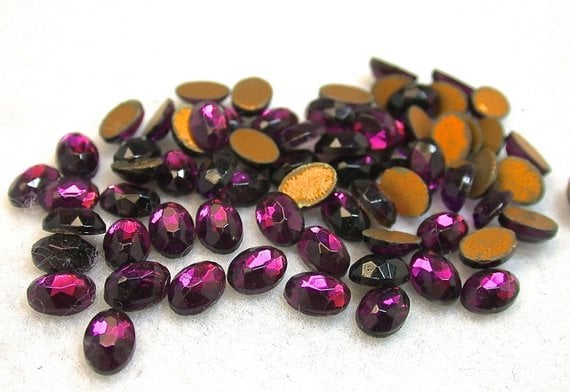
These vintage, faceted, purple glass rhinestones with gold foil backings resemble amethysts. Photo © Joel E. Arem, PhD, FGA. Used with permission.
Scorolite
Purplish glass or quartz pieces sold as opal simulants and sometimes misidentified or misrepresented as rare, faceted scorodites. Sometimes misleadingly referred to as "scorolite opal."
Sea Glass
Discarded manufactured glass pieces weathered for years by ocean water until washed onto beaches all over the world. As known as "beach glass" or "drift glass," this material has become a popular jewelry item.
Slocum Stone
Glass used to imitate opal. Silicate glass with Na, Mg, Al, and Ti; hardness = 5.5-6.5; no cleavage; conchoidal fracture; tough tenacity; SG = 2.41-2.51; N = 1.49-1.53 (may show a kaleidoscopic effect in crossed polars).
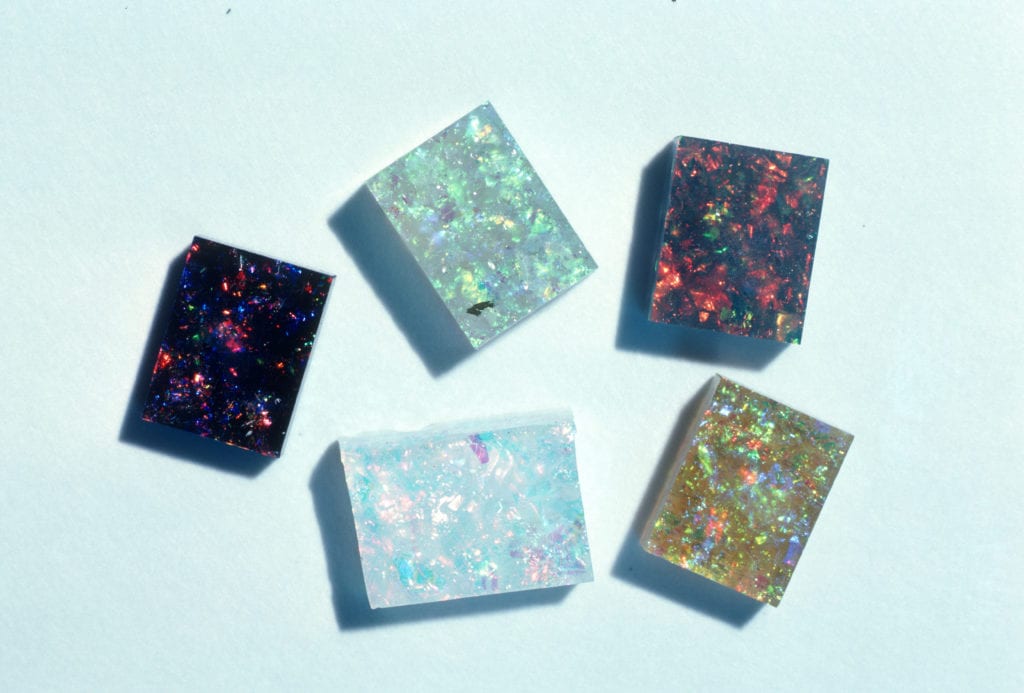
Slocum Stone blocks, about 1/2″ square. Photo © Joel E. Arem, PhD, FGA. Used with permission.
Slocum Stone can also simulate opal's characteristic play-of-color effect when viewed from different angles. Under magnification, these pieces may show inclusions that look like confetti.
Strass
Historically, a type of facetable glass with a high RI, developed by the Viennese goldsmith Joseph Strasser in 1758 and used as a diamond simulant. Today, the term may also refer to glass with a high lead content or to rhinestone.
Uranium Glass
Also known as Vaseline glass, uranium glass gets its typically green to yellow and yellow-green color from the addition of uranium dioxide. This material enjoyed some popularity from the mid-19th century until World War II. Uranium glass will fluoresce vividly under ultraviolet light (UV). Most of the housewares and jewelry items made from this material are safe to handle. However, it may be prudent to have the radioactivity of any piece measured in a laboratory, especially if you're considering cutting it.
Uranium glass beads on a black background under incandescent light and UV light. Photos by Wombat1138. Licensed under CC By-SA 3.0.
Victoria Stone
Also known as Imori Stone (after its inventor, Dr. S. Imori) and Kinga Stone, this glass was developed in Japan in the mid-1950s. Its production was discontinued in 1985, and the exact manufacturing process remains unknown. This complex silicate glass can show many colors. Some pieces will display chatoyancy, due to their fibrous structure. It has been used as a simulant for many gemstones, including blue pectolite.
Green Victoria Stone used to simulate jade may be called "metajade."
- Nephrite simulant: N = 1.61; SG = 3; hardness = 6.
- Jadeite simulant: N = 1.50; SG = 2.80; hardness = 6.
Enhancements for Glass Gemstones
You can easily identify faceted glass with foil backs (rhinestones) by looking at their pavilions. They're usually opaque and show a different color than you see face up. Richly colored rhinestones are used very frequently in costume jewelry.
Glass can receive many types of treatments to imitate a wide variety of gemstone colors, textures, and phenomenal effects.
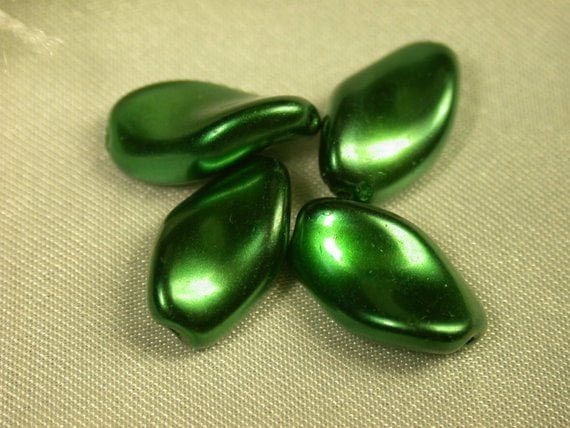
These faux pearl beads (green pressed glass) have a coating which gives them a pearly luster. Photo © Joel E. Arem, PhD, FGA. Used with permission.
Caring for Your Glass Gemstones
There's no single best way to clean glass jewelry. Some pieces have treatments which may react poorly to typical household glass cleaners or mechanical cleaning systems, especially surface coatings and foil backs.
Since household dust has a hardness (7), which exceeds that of most glass gemstones, use a lint-free cloth for manual cleaning and resist the urge to just scrub away dirt or grime.
Mild soap and warm water should be safe for most non-treated and non-backed pieces.
Although glass may be inexpensive and is certainly not rare, antique pieces may have historical or sentimental value. Furthermore, some manufacturing processes no longer exist, so replacing something like a Victoria Stone, for example, may prove very difficult. Consult with an antique specialist for the best way to clean such pieces.
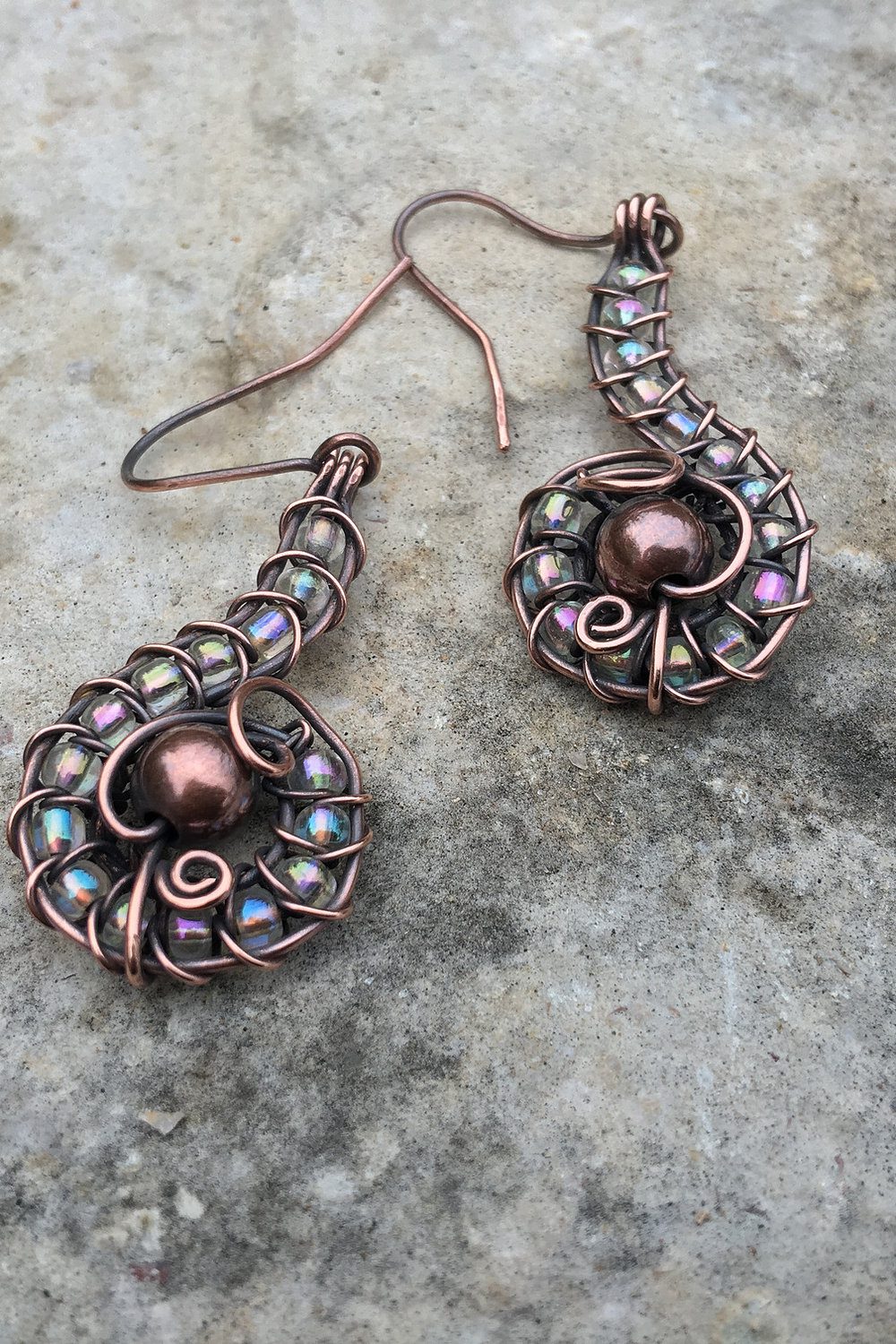
Beaded copper weave and large copper bead earrings with iridescent glass beads. Photo © Adornments by Mae. Used with permission
Whats on the Back of Glass Gem Stone
Source: https://www.gemsociety.org/article/glass/
0 Response to "Whats on the Back of Glass Gem Stone"
Post a Comment